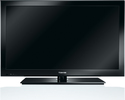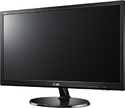A High Definition (HD) ready TV has a native resolution of 1366x768 pixels and a interlaced resolution of 1920x1080 pixel. He must provide a HDMI or DVI connection with HDCP (=copy protection) support. Furthermore he must be able to display HD-content from any HD-source (for example: BluRay-Player).
LED PICTURE QUALITY
In LED televisions, LEDs (Light Emitting Diodes) are used for backlighting purposes. When LEDs are used in televisions, they vastly improve picture quality and lower power consumption.
HOW LCD SCREENS WORK
To understand the benefits of LEDs, one must first understand how an LCD (Liquid Crystal Display) works. An LCD consists of an area of pixels (over two million in the case of a Full HD television) arrayed in front of a light source (backlighting); in a very simplifi ed form you can imagine an LCD to be like a slide projector, where the lamp represents the backlighting and the slide is the screen. In LED televisions, LEDs (Light Emitting Diodes) are used for backlighting purposes. A diode is just a few millimetres in size and converts power into light very effi ciently. It also responds to fluctuations in brightness much faster than a fluorescent tube, which is used in conventional LCD televisions. The light spectrum of LEDs means that the colours displayed on LCD TVs appear extremely natural. When LEDs are used in televisions, they vastly improve picture quality and lower power consumption.
LEDS IN TELEVISIONS: SLIM LED AND DIRECT LED
When using slide projectors, dark images cause problems, since the light from the lamp always shines through the slide, even in areas that are supposed to be black. This creates a rather greyish black colour – not only with slides but also LCD and LED televisions. Two different techniques are used to counteract this effect: global and local dimming. With global dimming, the whole backlighting is dimmed during dark scenes.
Returning to the example of a slide projector, this would mean the lamp would simply shine less brightly when dark slides were being shown. As a result, the entire image appears darker and the level of black improves drastically. Global dimming is used in LCD TVs with conventional and LED illumination (edge LED), thus improving the display of the colour black. With edge LED devices the screen is illuminated by light emitting diodes in the frame behind the LCD, which makes it possible to use a very narrow housing (slim LED). Diffuser plates are employed to distribute the light evenly. Local dimming goes a crucial step further, but it can only be used in LED TVs with direct LED backlighting. Imagine that, rather than one large light source for the entire screen, lots of small lamps are used instead. This is the principle behind LED TVs with direct LED backlighting. The light emitting diodes are positioned entirely behind the display and work in groups (clusters) that function independently of one another to control the brightness. So with local dimming, an on-screen image can be displayed that consists of some very bright and some very dark areas simultaneously. As a result, black no longer appears grey, because the LEDs in the corresponding sectors only emit very little light, or no light at all. At the same time, bright portions of the image are supplied with a lot of light, thus achieving a very high level of contrast.
REGZA ACCURATE DIMMING
Backlighting is divided up into different sectors (or "clusters") consisting of multiple LEDs. Each cluster can be controlled individually and adopt its own brightness value. Toshiba has also developed a special diffusion filter, which can be used to distribute the light within a group of LEDs even more accurately. This advance enables the screen to be illuminated much more precisely than was previously possible.
LOW POWER CONSUMPTION
LEDs consume much less power than fluorescent tubes at the same level of light output. This is not only good for your pocket, but for our environment too – and it also achieves a considerably improved picture quality.
Sintonizador de la TV
Puertos e Interfaces
- Número de puertos HDMI

- 3
- PC (D-Sub)

- Si
- Versión HDMI
- 1.4
- Cantidad de puertos USB 2.0

- 1
- Video componente (YPbPr/YCbCr) entrada

- 1
- Entrada de video compuesto

- 1
- Cantidad de puertos SCART

- 1
- Entrada de audio para PC

- Si
- Salidas para auriculares

- 1
- Audio digital, salida optica

- 1
- Interfaz común

- Si
- Interfaz común Plus (CI+)

- Si
- Control de electrónica de consumo (CEC)
- Anynet+
Características de administración
Control de energía
Exhibición
- Diagonal de la pantalla

- 66,04 cm (26")
- Tipo HD

- HD-Ready
- Compatibilidad 3D

- Si
- Brillo de pantalla

- 400 cd / m²
- Resolución de la pantalla

- 1366 x 768 Pixeles
- Relación de aspecto

- 16:9
- Razón de contraste (típica)

- 1000:1
- Relación de contraste (dinámico)

- 1000000:1
- Filtro peine
- Si
- Reducción de ruido
- Si
- Tiempo de respuesta

- 8 ms
- Ángulo de visión, vertical

- 178°
- Ángulo de visión, horizontal

- 178°
- Tasa de movimiento de alta frecuencia
- 50 Hz
Contenido del embalaje
- Pilas incluidas
- Si
- Soporte de sobremesa
- Si
- Manual de usuario
- Si
Peso y dimensiones
Empaquetado
Otras características
- Tamaño de pantalla visible (diagonal)
- 66 cm
-
Toshiba Regza LCD TV 32PB10E Menu
Lcd TV Menu.
-
Toshiba SL738 serie, o.a. 32 inch (32SL738)Toshiba LED tv! Video demo!
http://www.plasma-discounter.nl/led-tv/toshiba-led-tv/toshiba-led-tv-cat-1575_272.htm Toshiba SL738 serie verkrijgbaar in de volgende inch maten. Toshiba SL7...
-
TOSHIBA 32AV500P - KenotronTV Файлообменник - Service manual TV LCD
KenotronTV → Файлообменник → Ремонт телевизоров и другой аппаратуры. → http://www.kenotrontv.ru/forum/forum/5-%D1%84%D0%B0%D0%B9%D0%BB%D0%BE%D0%BE%D0%B1%D0%B...
-
Toshiba HD Ready LED TV How Get to Test card Channel on Saorview
Saorview Uploaded Channel How Get to Test Card on Saorview Channel is [12] [13] [14] and [15] Enter Your Remote Channel No. on The Remote Channel 11 / 17 / 1...
-
Toshiba 26SL738 menu
Service menu.
-
Toshiba Regza LCD TV video play (32PB10E)
Playing a 720p mp4 video file.
-
Toshiba REGZA 42-Inch 1080p HD LCD TV.flv
Sale Page : http://best3dtv.i-offer.biz/toshiba-regza-42-inch-1080p-hd-lcd-tv/
-
Prestige Digital. Toshiba Lcd repair service, Devon and Cornwall
Welcome to Prestige Digital! Prestige Digital Services offer a repair solution for all television and audio visual equipment. Established in 1989, we have ov...
-
How to Access Service Menu in Toshiba TV
How to Access Service Mode in Toshiba TV's.
-
How to fix Toshiba Regza 32AV615DB / 42SL738R TV changing channels on its own
About a year after I purchased my Toshiba Regza 32AV615DB TV, it started changing channels on its own, making it unusable. I searched hi and low looking for ...
-
Resetting V-chip on Toshiba TV's
If you want to watch an inappropriate TV show while your parents are out, but they set the V-chip, then here's how to reset it so that you can watch the show...
-
Toshiba 32RL933 32RL953 40RL933 40RL953 - Solarised picture - Diagnosis & Repair
Fault: noisy image, black replaced with green, red or blue, sometimes intermittent. Also will apply to other TVs. I've fixed quite a few TVs with faulty LVDS...
-
Toshiba Regza 46SL733 Green Picture Problem
See beard and hair. Very low angle of view. It's much much more green but my camera fixes colors automatically. But this may give you an idea. Check how wide...
-
Toshiba SL Series - YouTube.mp4
http://www.dagvergelijker.nl/pages/article/article-catalogdetails/1728923-toshiba-32sl733.asp http://www.dagvergelijker.nl/pages/article/article-catalogdetai...
-
Toshiba ZL1 - Menu a schermo
Navighiamo nel menù a schermo del TV 55ZL1 di Toshiba con CEVO Engine. La prova completa è su DDay.it.
-
Toshiba Regza SV685 menu
Un video con le funzionalità e i menu del TV Toshiba SV685.
-
Toshiba 55UX600U
Toshiba 55UX600U 55-Inch 1080p 120 Hz LED HDTV with Net TV - created at http://animoto.com.
-
Produktvideo SL738-Serie
Im Wohnzimmer, Schlafzimmer, Hobbyraum oder im Gartenhäuschen - die Fernseher der SL738-Serie bringen schlankes Design und stromsparende LED-Technik in jeden...
-
Toshiba IK1850 - faulty vertical lines demo footage
This is a test sample of a faulty 1980 Toshiba IK-1850 vidicon video camera. While the image quality (detail, colours) are surprisingly good, there's an inte...
-
Toshiba 46VL748G Menü
Menü vom 46 Zöller.

























